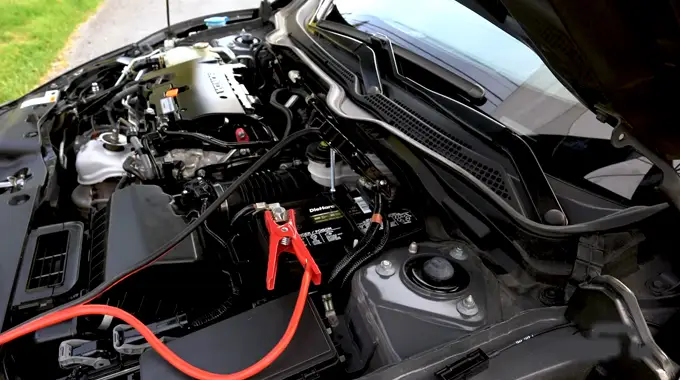Last Updated on May 1, 2023
Deep cycle batteries are designed to be discharged and recharged repeatedly, but when they run out of power, you may want to use a pair of cables to recharge them. Perhaps you may have a question, can you charge a deep cycle battery with jumper cables?
An emergency high-peak jumper cables kit can be a lifesaver if you become stuck on the side of the road with a dead deep cycle battery. These jumper cables (AKA booster cables) are simply a pair of cables with alligator clips on each end. One end of the cord is connected to the energy source, and the other end is attached to the terminals of the deep-cycle battery.
The charging process of a deep cycle battery with jumper cables should be conducted according to the specific steps outlined in the following article.
How Can You Charge a Deep Cycle Battery With Jumper Cables? – Step By Step Guide
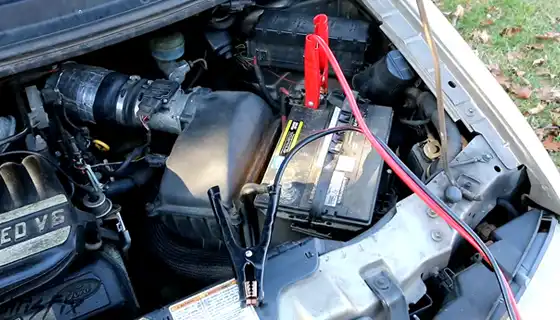
Recharging a deep cycle battery with a jumper cable set, you will need the following materials:
- A set of jumper cables
- A working vehicle battery or power source
If you are using a car battery to charge your deep-cycle battery, follow the steps below:
Step 01. Choose the Properly Rated Jumper Cables
When choosing a jumper cable, you must select the properly rated jumper cables. High-peak jumper cable kits are typically rated in Ampacity, the maximum current that the jumper cables can safely carry.
You should select a jumper cable automotive car kit with an Ampacity rating greater than the current being drawn from the battery. For example, if a deep cycle battery is being charged with a car battery, you must select a jumper cable with an Ampacity rating of at least 10 amps.
Step 02. Turn on the Car Engine
Before proceeding, ensure that the car engine is turned on and running to provide electricity to the deep-cycle battery. The voltage of a car battery (12V) is greater than the voltage of a deep cycle battery (6-12V).
When you connect the two batteries, the car battery will try charging the deep-cycle battery. This can damage the deep cycle battery if it cannot handle the higher voltage. Turning on the car engine will provide a regulated voltage of 12V to charge the deep-cycle battery.
Step 03. Attach the Cable Ends to Power Source
The next step is to attach the heavy-duty jumper cable ends to the car battery. To do this, hold the red cable end and attach it to the car battery’s positive (+) terminal. Then, hold the black cable end and connect it to the donor car battery’s negative (-) terminal.
Always ensure that the cables are securely attached and keep other positive & negative cable ends away from each other. If they touch, a spark may occur and damage the car battery.
Step 04. Attach the Cable Ends to Deep Cycle Battery
Once the cables are securely attached to the car power source, attach one end of each cable to their corresponding terminals on the deep-cycle battery. The red cable must be connected to the positive (+) terminal, and the black cable should be connected to the negative (-) terminal.
Ensure the terminals are clean and free of any corrosion before connecting the cables. If there is any dirt or corrosion, it should be removed with a wire brush or electrical cleaner. Also, remember not to touch the cables’ two ends together when connecting them to the deep-cycle battery.
Step 05. Let the Battery Charge for Several Minutes
Once the cable terminals are securely attached to both batteries, let them charge for several minutes. In this timeframe, the deep-cycle battery will slowly begin to charge. You should also check the voltage of the batteries periodically with a digital multifunction battery monitor meter during the charging process.
Following these simple steps, you can effectively recharge a deep-cycle battery pack with jumper cables. Remember to use the properly rated jumpers and ensure that all connections are secure before beginning the charging process.
Can You Charge a Marine Deep Cycle Battery Via Jumper Cables and a Running Car Battery?
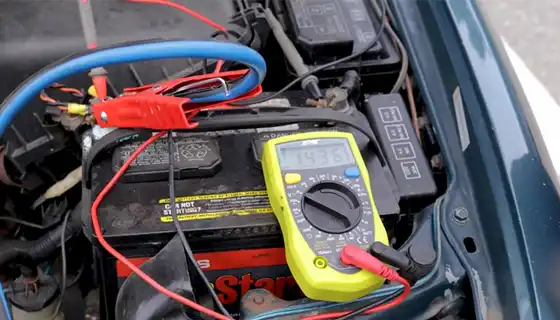
Yes, marine deep-cycle batteries can be charged with heavy-duty jumper cables and a powered car battery. But, you should note that doing so will not result in a quick or efficient charge. The following occurrences must also be considered:
- To minimize the risk of damaging the car’s battery and its electronics, which can be costly to replace, the car must be able to start with both batteries already connected.
- The deep cycle RV battery may take up to eight hours to fully charge the battery.
- There must be a matching voltage between a deep cycle and car batteries.
- When charging via a jumper cable set and a running car battery, keeping an eye on the deep cycle battery’s amperage and temperature levels is essential.
- You should never charge unsupervised, as there have been reports of explosions when jumpers are left connected for too long.
The best option is still to use an appropriate deep-cycle car battery charger (if you have one nearby) explicitly made for this purpose. This will ensure your battery remains in good health and charges quickly and efficiently.
Are There Any Risks of Using Jumper Cables to Charge a Deep Cycle Battery?
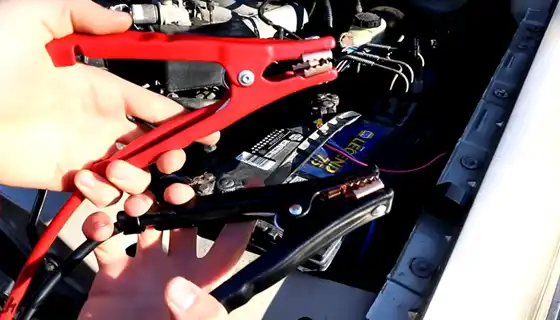
Yes, some risks are associated with using jumper cables to charge a deep-cycle battery. Some of these risks include:
May Damage the Car’s Battery
Using jumper cable sets to recharge a deep-cycle battery can draw too many cranking amps to the battery and cause it to overheat. Which can lead to severe damage, including a dead car battery.
This charging process involves connecting two batteries together. If the connection is not made correctly, it can create a spark that could cause an explosion or fire.
Deep cycle batteries can also become overcharged if the connection is not broken quickly enough after charging is complete. This could damage the battery and potentially cause it to leak dangerous acids or other hazardous materials.
Overload the Charging System
Improper connections can overload the charging system, damaging wiring and other electrical components. This damage can also stress the alternator, leading to further problems down the line, including engine stalling or reduced engine performance.
It is also possible for reverse polarity issues to occur, in which case one of the battery’s terminals will be connected incorrectly to its corresponding terminal on the other battery. This could further damage the batteries and any electronic devices connected to them at the time.
Discharged More Quickly
Even when a proper connection between two batteries (while using a car battery for charging) has been established, there is always a chance that one of them will be discharged more quickly than expected due to incorrect sizing or wrong electrical contacts within either battery itself.
In such cases, it may result in uneven charging between both batteries; it might even lead to an imbalance in their individual cell voltages, which would be an incredibly damaging condition for either battery and could cause irreversible damage if left unchecked for too long.
Permanent Damage to the Battery Cell
If too much battery voltage is applied, it can cause permanent damage to the deep-cycle battery cells within the battery, leading to a reduced capacity over time or even causing them to fail completely.
Similarly, too much current can damage electrical components such as relays and fuses in the charging system, which will require replacement.
Also, if you attempt to jump-start a car while its engine is running, this could overload or blow out any sensitive circuits within its electrical control unit, which would need professional repair or replacement.
What Precautions Should You Take When Charging a Deep Cycle Battery Through Jumper Cables?

As you can see, jumper cables pose a number of risks when used to charge deep-cycle batteries. You must take some necessary precautions when doing so to avoid any of these potential issues, such as:
Make Sure the Cables Clamps Aren’t Touching
To recharge a deep cycle battery pack using jumper cables, you must ensure that the clamps of the jumper cables do not touch each other. If they do, a spark may be created and cause a fire or even an explosion.
When connecting the clamps to the battery terminals, always attach the positive terminal first, followed by the negative. Before turning on the battery, ensure that the clamps are securely connected.
Always Wear Protective Gear
Whenever you want a deep-cycle battery to be recharged by using a set of jumper cables, it is always critical to wear protective gear. Safety glasses, rubber gloves, and long sleeves are all integral components of a person’s safety gear when working with batteries.
Safety glasses protect the eyes from splashes of battery acid or sparks that could occur when the battery is being charged. Rubber gloves protect from the electric shock that could occur if there is contact between exposed metal parts and the jumper cables.
Long sleeves protect arms from burns caused by sparks or accidental contact with hot surfaces, such as battery terminals.
Disconnect the Cables When Battery Gets Overheats
Deep cycle batteries may overheat when charged via jumper cables. So you must immediately disconnect the cables and allow the battery to cool down when it gets hot. Overheating can be extremely dangerous when dealing with batteries, as overheating can cause them to combust and potentially start a fire.
It is always best practice to monitor your battery’s temperature while charging, using tools such as thermometers or thermal imaging devices, if possible. Also, it is recommended that you place your battery on fireproof surfaces, such as concrete or ceramic tiles, away from any combustible materials.
Is it possible for Jumper Cables to Damage Your Deep Cycle Battery When Charging it?
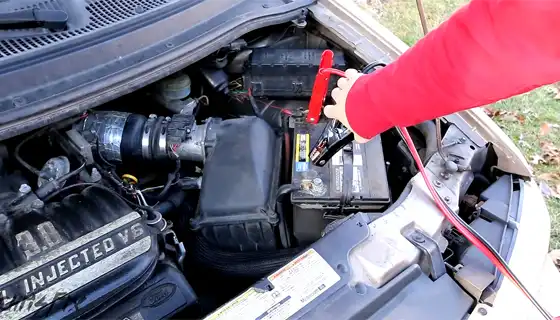
If misused or left attached for an extended period with the battery, jumper cables can damage your deep-cycle battery. When the current produced by the jump start is higher than your deep cycle battery intended to handle, it will start to overcharge.
Overcharging can damage not just the battery itself but also its internals. The protruding plates inside the cells become corroded as they are exposed to excessive current and voltage. This corrosion erodes away at their surface, reducing their ability to produce energy and leading to decreased battery performance over time.
Also, when left connected for too long, the jumper cables will eventually draw out all of the electrolytes from inside the cells, leaving them unable to store energy properly. Thus unable to power your vehicle’s electrical system like headlights, music systems, windshield wipers, etc.
Can a Completely Dead Deep Cycle Battery be Recharged With Jumper Cables?
It is possible to recharge a fully drained deep-cycle battery using jumper cables, but it requires careful and precise attention to detail. The contact points of the deep cycle battery must be carefully cleaned with a wire brush or sandpaper. This helps ensure a strong connection between the battery and the jumper cables.
Before turning on the donor vehicle engine that will provide jump-start power to your dead battery, you must ensure all lights and accessories of the donor vehicles are turned off to reduce any potential damage from the high current draw.
After connecting both cables, start up the donor vehicle and wait for about five minutes before attempting to start up the vehicle with the dead deep cycle battery.
Once everything looks secure, attempt to start your vehicle with a drained deep-cycle battery. If successful, make sure you leave it running for proper charging time to allow adequate recharge for your battery before shutting down.
Is it Better to Charge a Deep Cycle Battery Using Jumper Cables?
It is generally not a wise idea if you are unfamiliar with the procedures for charging deep-cycle batteries with jumper cables. Jumper cables may provide too much current for a deep cycle battery and can cause damage to the battery, shorten its lifespan, and even create a safety risk.
But if you don’t have another option left and have to jump-start your deep cycle battery, follow all the above-mentioned steps and use extreme caution. For safety reasons, it is always recommended to use a stable automotive smart multi-voltage battery charger specifically designed for deep-cycle batteries.

